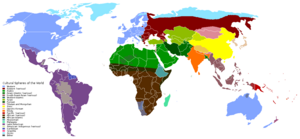
Back جغرافيا ثقافية Arabic Mədəni coğrafiya AZ Культурная геаграфія BE सांस्कृतिक भूगोल BH সাংস্কৃতিক ভূগোল Bengali/Bangla Geografia cultural Catalan Kulturní geografie Czech Культурăлла географи CV Daearyddiaeth ddiwylliannol CY Kulturgeografi Danish

| Part of a series on |
| Geography |
|---|
 |
Cultural geography is a subfield within human geography. Though the first traces of the study of different nations and cultures on Earth can be dated back to ancient geographers such as Ptolemy or Strabo, cultural geography as academic study firstly emerged as an alternative to the environmental determinist theories of the early 20th century, which had believed that people and societies are controlled by the environment in which they develop.[1] Rather than studying predetermined regions based upon environmental classifications, cultural geography became interested in cultural landscapes.[1] This was led by the "father of cultural geography" Carl O. Sauer of the University of California, Berkeley. As a result, cultural geography was long dominated by American writers.
Geographers drawing on this tradition see cultures and societies as developing out of their local landscapes but also shaping those landscapes.[2] This interaction between the natural landscape and humans creates the cultural landscape. This understanding is a foundation of cultural geography but has been augmented over the past forty years with more nuanced and complex concepts of culture, drawn from a wide range of disciplines including anthropology, sociology, literary theory, and feminism. No single definition of culture dominates within cultural geography. Regardless of their particular interpretation of culture, however, geographers wholeheartedly reject theories that treat culture as if it took place "on the head of a pin".[3]